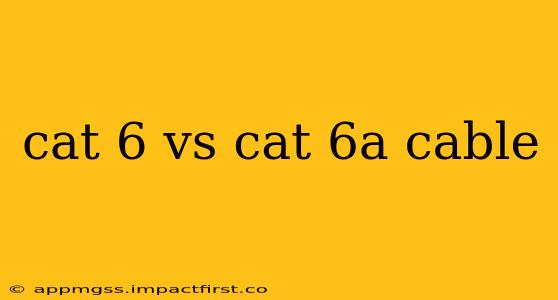Choosing the right Ethernet cable can be confusing, especially with so many options available. Two of the most common choices are Cat 6 and Cat 6a cables. While both offer Gigabit Ethernet speeds, there are key differences that determine which one best suits your needs. This guide will break down the distinctions between Cat 6 and Cat 6a cables, helping you make an informed decision.
What is Cat 6 Cable?
Cat 6, or Category 6, cable is a twisted-pair copper cable designed to support Gigabit Ethernet speeds up to 1 Gigabit per second (Gbps) at distances of up to 100 meters (328 feet). It’s a reliable and widely available option, often chosen for home networks and smaller office setups. Its performance is generally sufficient for most everyday internet activities, including streaming high-definition video and online gaming. However, it starts to show limitations as bandwidth demands increase.
What is Cat 6a Cable?
Cat 6a, or Category 6 Augmented, cable is an enhanced version of Cat 6. It boasts superior performance, supporting 10 Gigabit Ethernet speeds (10Gbps) up to 100 meters. The "augmented" designation signifies improvements in the cable's construction, leading to significantly better signal integrity at higher frequencies. This makes it ideal for environments with higher bandwidth requirements, such as larger offices, data centers, and situations where 10 Gigabit Ethernet is utilized.
Cat 6 vs Cat 6a: Key Differences
The primary differences lie in their performance capabilities and construction:
-
Bandwidth: Cat 6a significantly outperforms Cat 6 in terms of bandwidth capacity. While Cat 6 is suitable for Gigabit Ethernet, Cat 6a handles 10 Gigabit Ethernet with ease, offering a future-proof solution for increasing bandwidth demands.
-
Alien Crosstalk: This is a crucial factor influencing cable performance. Alien crosstalk refers to signal interference between adjacent cables. Cat 6a features improved shielding and twisting techniques to minimize this interference, ensuring more reliable signal transmission, especially at higher frequencies.
-
Frequency Range: Cat 6a supports a higher frequency range than Cat 6, allowing for faster data transfer rates and improved signal quality.
-
Cost: Generally, Cat 6a cables are more expensive than Cat 6 cables due to their superior construction and performance capabilities.
What is the difference between Cat6 and Cat6a cables in terms of speed?
The most significant difference between Cat 6 and Cat 6a is speed. While both support Gigabit Ethernet (1 Gbps), Cat 6a is designed to support 10 Gigabit Ethernet (10 Gbps) over longer distances. This makes Cat 6a ideal for high-bandwidth applications that demand significantly faster speeds. For most home users, the speed difference won't be immediately noticeable, but Cat 6a provides future-proofing for those who anticipate needing higher bandwidth in the coming years.
Is Cat 6 or Cat 6a better for gaming?
For most gaming scenarios, Cat 6 offers sufficient speed. The improved performance of Cat 6a might offer a slight advantage in reducing latency in high-bandwidth online games, especially in competitive multiplayer settings. However, the difference might be negligible for many gamers unless they are using very high-bandwidth applications or experiencing significant network congestion. The choice often depends more on the overall network setup and other contributing factors to latency rather than solely the cable type.
Which cable should I choose – Cat 6 or Cat 6a?
The best choice depends on your specific needs and budget.
-
Choose Cat 6 if: You need a reliable Gigabit Ethernet connection, have a budget-conscious approach, and don't anticipate needing 10 Gigabit Ethernet speeds in the foreseeable future. It's suitable for most home users and small offices.
-
Choose Cat 6a if: You require 10 Gigabit Ethernet speeds, have a demanding network environment (data center, large office), prioritize future-proofing your network, and have a higher budget.
Ultimately, while Cat 6 remains a solid option for many applications, Cat 6a provides a significant performance upgrade for those who need the extra bandwidth and future-proofing. Consider your current and future bandwidth requirements to make the best decision.
